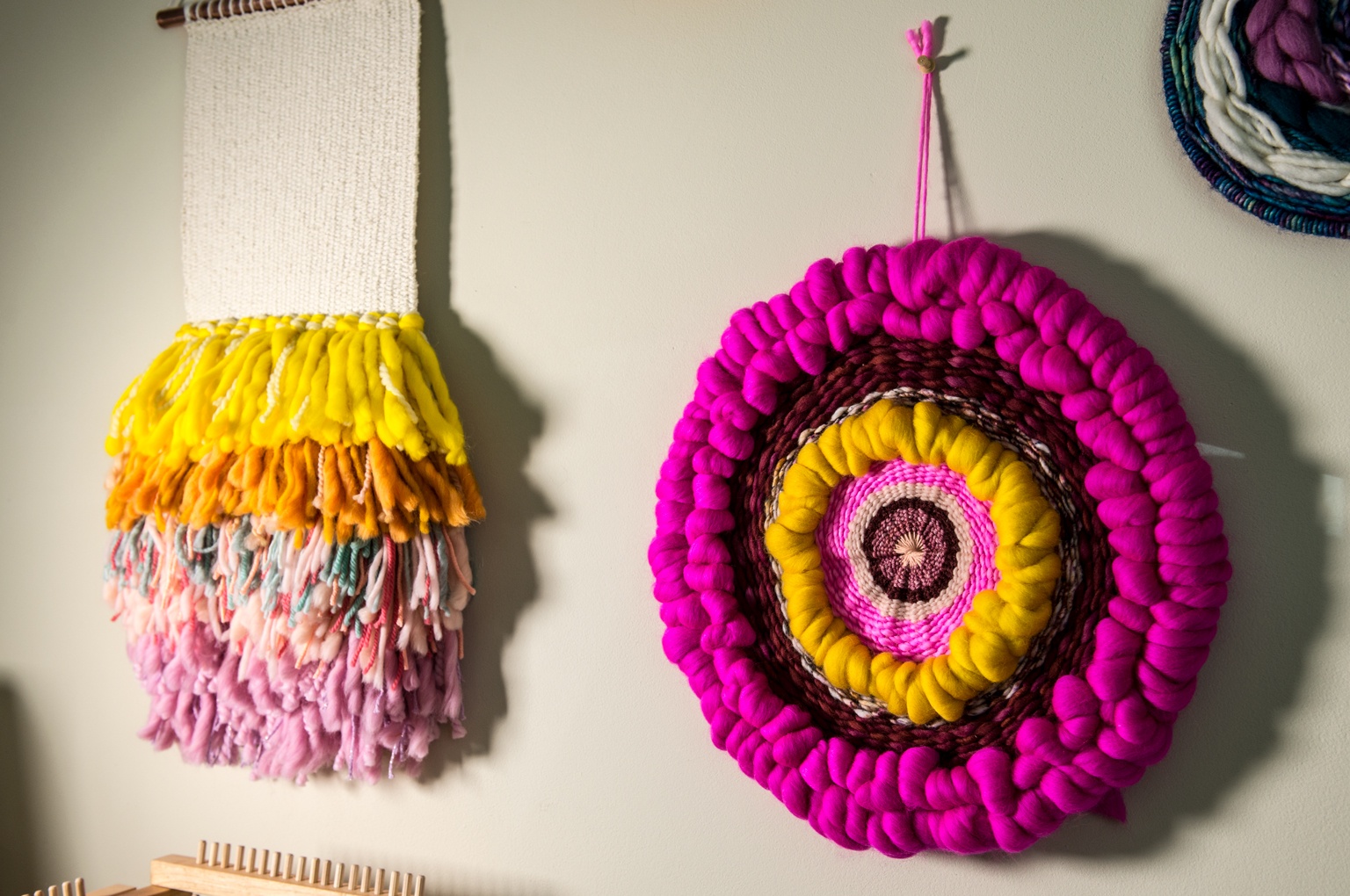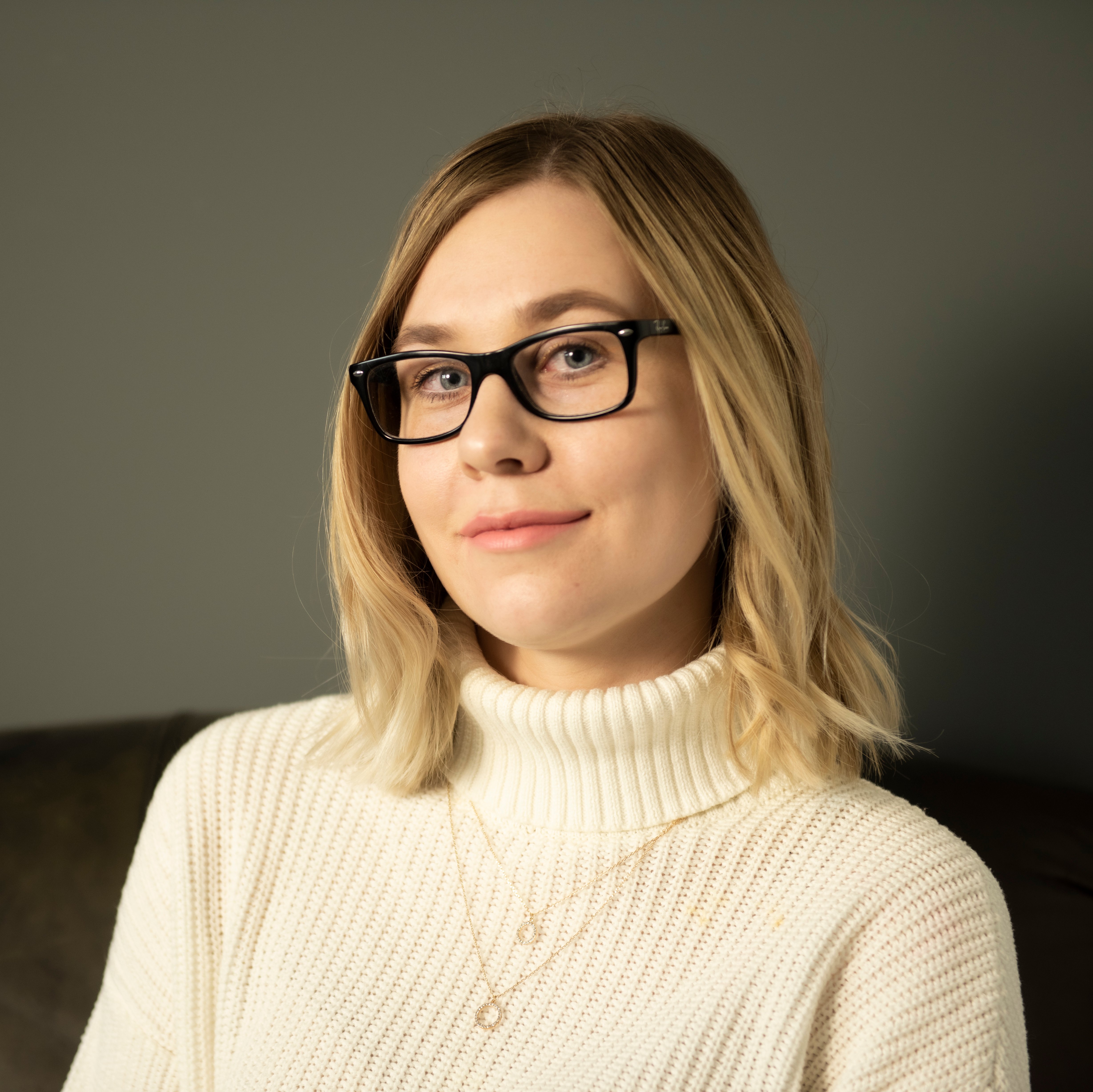Makers 1-on-1 is our original interview series featuring today's makers and DIYers. We're sitting down with new makers every week to learn more about their projects, how they acquire information, their purchase processes, and their passions.
 This week, we’re interviewing Sarah Harste — a yarn and macrame weaver, workshop teacher, and owner of Sarah Harste Weavings in Columbus, OH. Sarah is self-taught in loom weaving and even builds some of her own looms for uniquely sized weaving projects. In her workshop, she uses a brightly-colored collection of wool yarn, looms and combs, needles, and scissors. If your brand markets to weavers and fiber artists, this 1-on-1 interview with Sarah will give you some important insights into building connections with makers like her.
This week, we’re interviewing Sarah Harste — a yarn and macrame weaver, workshop teacher, and owner of Sarah Harste Weavings in Columbus, OH. Sarah is self-taught in loom weaving and even builds some of her own looms for uniquely sized weaving projects. In her workshop, she uses a brightly-colored collection of wool yarn, looms and combs, needles, and scissors. If your brand markets to weavers and fiber artists, this 1-on-1 interview with Sarah will give you some important insights into building connections with makers like her.

What's your name and what do you do?
I’m Sarah Harste and I’m a fiber artist in Columbus. I run a business called Sarah Harste Weavings. I make weavings, which are just woven wall hangings, I make macrame pieces, and I also make lap looms for beginner weavers.
How and when did you get started weaving?
I started weaving about two and a half years ago. I always describe this magical day in February when I had a snow day off from work (I was working at a bookstore at the time) and I was like, “Ok. I’m finally going to learn to weave.” I had bought a loom like a month before online, and I sat down in my bed and literally didn’t get up for six hours, just trying to figure out how to weave. It was one of those magical moments when time falls away, and you’re so absorbed in what you’re doing. After that, I was just hooked — weaving was my thing.
What resources did you use to help you learn about weaving?
At the time, weaving hadn’t gotten as big as it has now. I was trying to look up blog posts or videos online, and it was really hard to find at the time. I think I was able to find one blog post that I was muddling my way through. After that, I just learned through practice. A lot of it was trial and error. I tell all my students that I made 50 bad weavings so we could get to the point where they could make a good one on their first try.
What does the process of weaving look like?
First, I have to go through and gather the fibers. I pick different colors and make a pile. Then I warp the loom — that’s adding the initial string going back and forth — and then I’ll go ahead and put the fringe on and start weaving. Once I’ve got it woven, I have to take it off the loom and put it on a dowel; then it’s ready to hang. The great thing about weaving is that you can always take it apart. A lot of times I’ll get halfway up, and that’s when it can either feel really good or it all falls apart. It’s a simple concept but people get really intimidated. It’s really not hard once you know how to do it.

What materials and tools do you need?
I mostly use yarn. I sometimes use silk ribbon or rope or cording. I have to use a loom, so I have a few different sizes. I use the lap looms I make, and then I have a larger one, and then another that’s about three and a half feet wide that my fiancé made me. However wide you want the weaving to be, that’s how wide your loom has to be. Then I use a comb, and a needle, and scissors to cut the yarn.
What qualities do you look for in a product you're going to use?
At first, all I used was acrylic yarn (which isn’t very good quality) because I’d never knitted or crocheted. I knew nothing about yarn, so it took some education. Now I try to use yarn that’s either wool or wool-blend. A lot of my work is very colorful, so I’m drawn to very brightly colored yarn. When I’m in the yarn store, those are the colors I gravitate towards: the colors that will knock you down. Color can be really scary for people, but once you give in to it, it’s definitely very addictive.
Do you form relationships with the brands you use?
Yeah! I try to shop at local yarn stores or with people that I follow online. A lot of the more “art yarn,” which is more chunky and has a more funky vibe to it, all of it comes from people that I follow online and that I have been following basically since I started weaving. There’s one girl who lives in Cincinnati named Beth Meyer, and her business is called Ugly Hank, and she does really cool, beautiful, crazy yarn. Some of it she hand dyes herself. Some of those people, when you purchase from them, it’s cool to see them get excited about the completion. They make the yarn, and it ends up in this weaving, and they get to see its whole journey and get really excited about it, and it makes you really excited about it.
What other types of things do you research?
I definitely had to research a lot of trial and error type things with weaving. There’s a lot of different ways to get it off the loom and achieve a certain look that you’re going for. For example, I’m using a ruler to hold the yarn up higher. It used to be that I would weave right on the bottom of the loom, but after research, I found that this is better to give me a space to knot it, instead of taking it off with only a little bit of loose space. Little tips and tricks like that help me. As far as business stuff, I try to go to a lot of talks around the area. I’m not good at reading a bunch of stuff and really absorbing it. I have to listen to podcasts or go to discussion groups to get it. It makes me feel better when I hear other people’s stories.

What social media platforms do you use?
I mainly use Instagram. I have a Facebook page, but I’m not as active on it as I would like, and I use Pinterest, too. I use Instagram mainly for marketing, like if I’m trying to get people to come to workshops, but I also just really use it to help my customers to feel closer to what I’m making. Obviously, I’m trying to do branded, pretty pictures and everything, but as far as Instagram Stories, I really like that I can hop on there and say, “Hey, I’m really frustrated today because I’m trying to do this and nothing is working.” Or I can show them my dirty, dingy basement where I’m making the looms. It lets them be a part of the process.
Who do you follow online?
I follow a lot of other weavers and macrame artists. Especially in terms of weaving, I feel like it’s a really cool community on Instagram because everyone is very supportive of one another. That’s really what got me into weaving. I also follow friends, a lot of creatives in Columbus and the Ohio area, and people that I’ve met at shows and everything. And also a celebrity account here and there.
How much time does it take to finish a weaving?
One that’s about 16 or 18 inches wide might take four to six hours, depending, whereas a smaller one might take and hour and a half or two hours. This is my full time job, and time management has been interesting. The hardest part about being your own boss is that you get caught trying to bullshit yourself pretty easily. If I have six things to do today, and there’s something I really need to be prioritizing, but instead I would rather do this other thing first — I got caught in that trap more in the first couple months, but now I have to put my adult pants on and think, “What am I going to do today? I’m going to do my taxes.” It’s been a transition for sure, but I feel like I’ve gotten to know myself better in a weird way, and how I operate, so that’s been fun and challenging.

Where do you get inspiration?
I get inspiration really from exciting color combos. I’m super inspired by colors, and I love the moment where you find these two or three colors that you think that would not go together at all, but when you put them together it’s like, “Wow.” It makes each color stand out but they look really cool together. I’m also inspired by following accounts on Instagram and kind of playing and experimenting, too. Normally, I have yarn everywhere, and I put them in little groups to see what looks good together.
What's it like teaching workshops to other aspiring makers?
So I teach Intro to Weaving, then I teach Macrame Wall Hanging, Macrame Plant Hanger classes, as well as Intermediate Weaving. I started teaching about a year ago in Columbus, and pretty quickly, the demand for them grew. I did one class and people were already asking when my next one would be. I started doing about a class a month, then a couple classes a month, and then I started branching out to places outside of Columbus. Now I go to places like Cincinnati, Cleveland, and Pittsburgh. I take the show on the road, travel to shops, and teach people to weave.
I think that people want to work with their hands, and they don’t get to as much as they want to. It’s kind of a craving when they come into these workshops. They feel unsure of themselves and maybe scared at first, and you see them blossom before your eyes as they’re learning, and they’re getting more confident in themselves and pushing themselves creatively. Workshops are my favorite part of what I do. After every one I feel a high afterwards; it’s so exciting and so much fun. I would say it’s the most rewarding part of what I do because you can make a weaving and you send it off, and you might never see anything about it again. Someone might not post a picture on Instagram; it’s just kind of gone. But you can go and teach a workshop, meet someone, hear their story — these workshops I teach are three or four hours long and I say, “Let’s get comfortable, let’s get to know each other, we’re going to be in the trenches for a little bit together.” I’m not working alone in a room; instead, I’m in this room full of people and I can see it affecting people.
How do you deal with problems and challenges?
I have to get it out of my head. I either have to write it down in a journal, or complain about it to my fiancé, or go with a friend to coffee. I feel like there’s no distractions when you’re working for yourself. When you have a big problem, it feels even larger because it’s all you’re thinking about. You’re stuck in this room alone with your problem. So it’s really helpful to talk it out with other people and get their perspective on it because a lot of times, you’re building it up in your head. Especially when you run your own business, you can get into this mindset where every decision feels like success or failure. So, talking it out with someone who is outside of that mindset and has a little more logic and distance really helps me put it into perspective, slow down, and see how I really feel about this when I’m taking my emotions out of it.

What's coming up next for you?
Next I’m going to be doing a lot of holiday markets. I also just launched a podcast which has been pretty new, and I’m trying to launch some kits soon for macrame and weaving, so that if someone’s not in Ohio, they can still learn from me in some way.
What motivates you to keep weaving?
Working for myself is in itself a big motivation. I feel like I wanted to get to this place for a long time. Even before I started weaving, I always felt like I wanted to be one of those people who worked for myself. I kind of couldn’t figure out how to do it; what was the formula, right? So wanting to stay afloat and keep going is good motivation when I wake up and think, “If I really wanted to, I could just watch Netflix all day,” but no, I’m going to sit down and answer these fifty emails. Also, it’s really nice to be a part of a good creative community. That’s really motivating when I sit down and talk to people who are going through the same thing, and it makes me feel like the struggle is worth it. And it’s pretty badass to say, “I’m an artist and I work for myself.”





